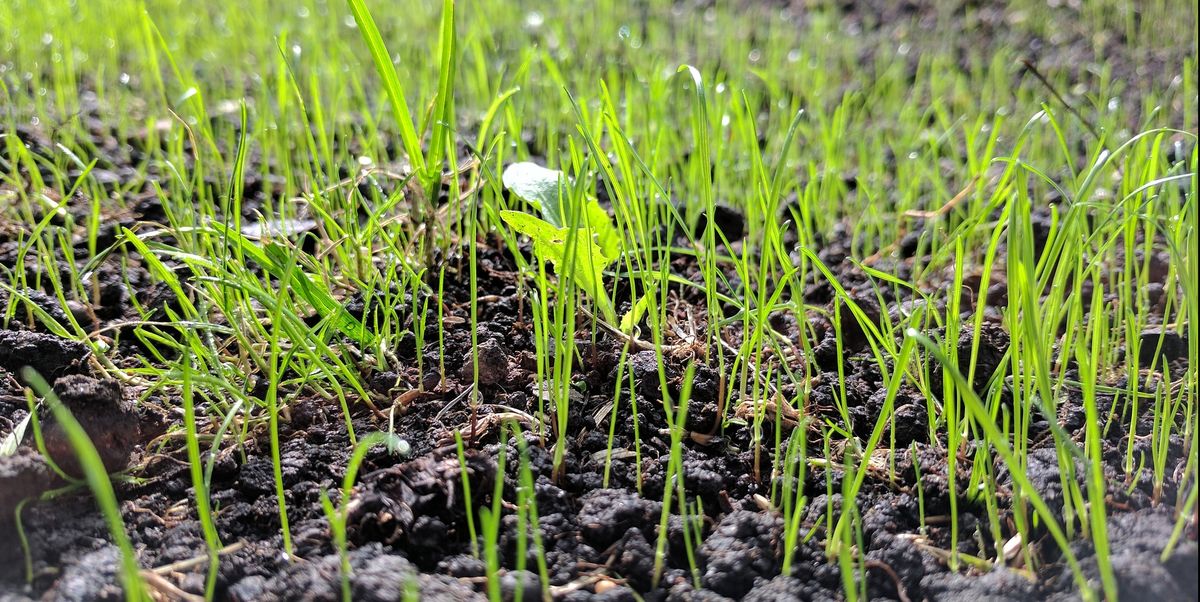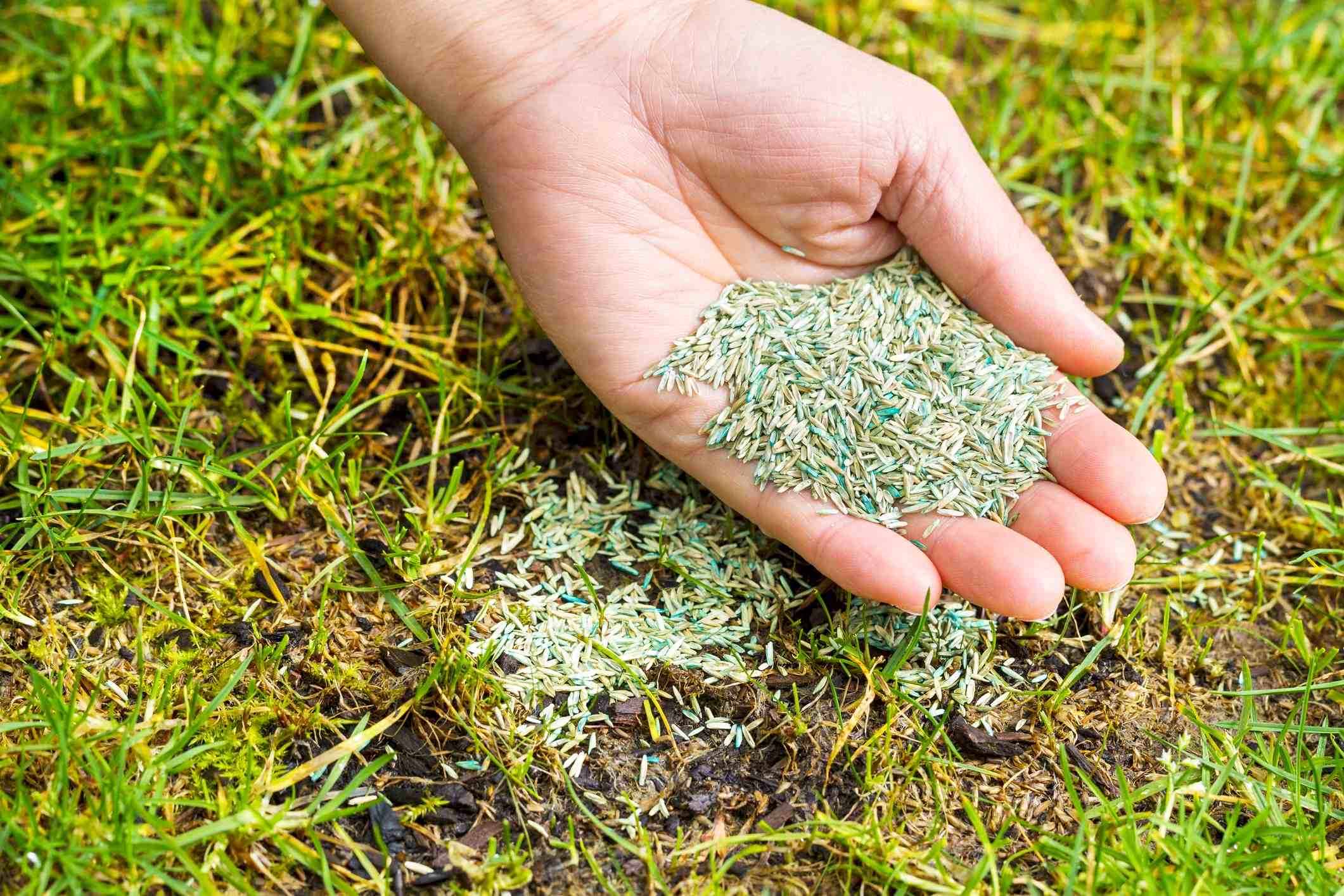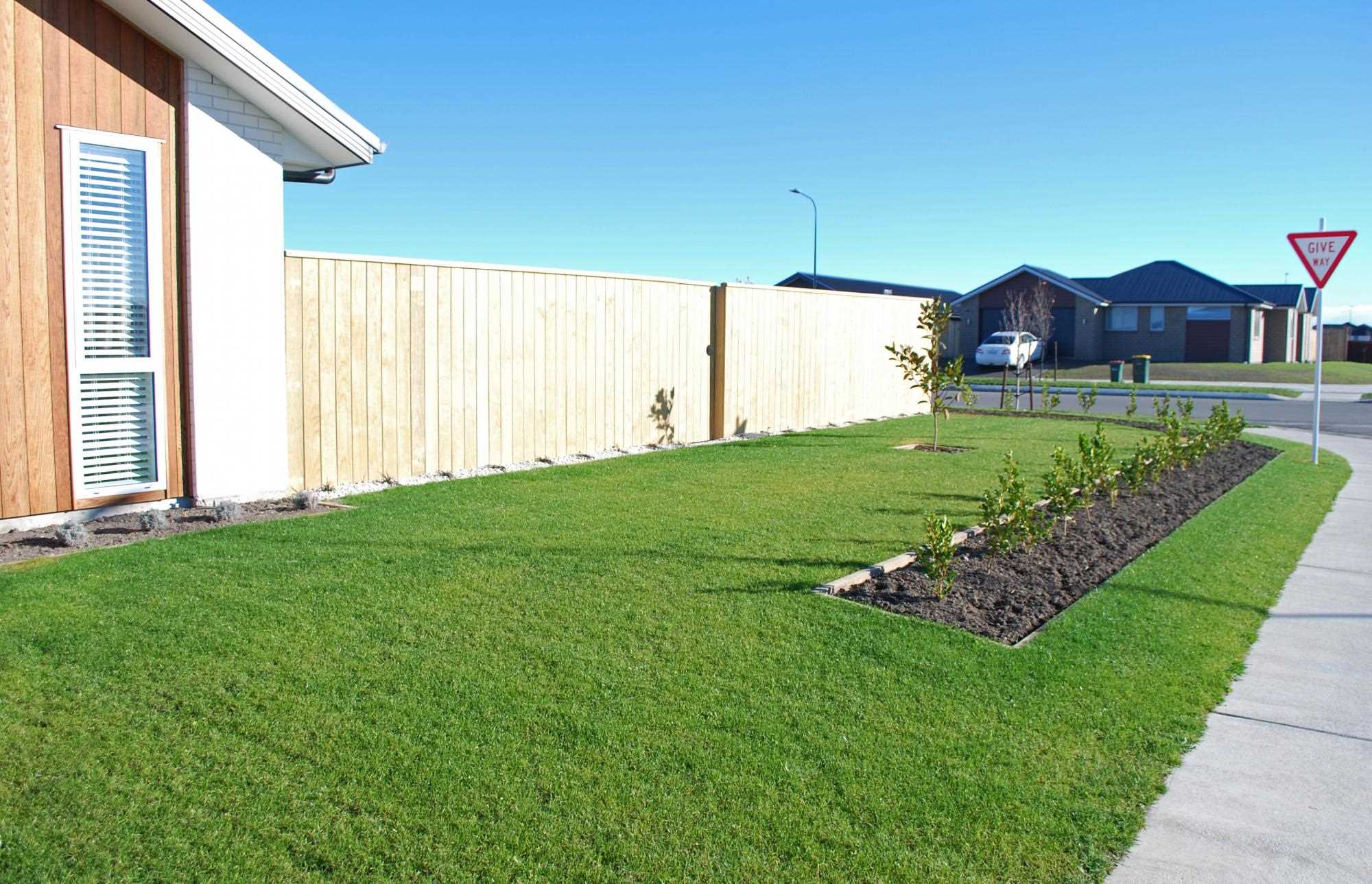Home>Gardening Basics>Understanding Soil>How To Grow Grass In Rocky Soil


Understanding Soil
How To Grow Grass In Rocky Soil
Published: February 13, 2024
Learn the essential tips and tricks for growing grass in rocky soil. Gain a thorough understanding of soil composition to achieve a thriving and lush lawn.
(Many of the links in this article redirect to a specific reviewed product. Your purchase of these products through affiliate links helps to generate commission for Chicagolandgardening.com, at no extra cost. Learn more)
Table of Contents
- Introduction
- Understanding Rocky Soil
- Assessing Soil Conditions
- Preparing the Site
- Selecting the Right Grass Species
- Soil Amendments and Conditioning
- Seed Selection and Planting
- Irrigation and Watering Techniques
- Fertilizing and Nutrient Management
- Weed Control and Maintenance
- Protecting the Grass from Erosion
- Conclusion
Introduction
Welcome to the world of gardening in challenging conditions. If you’ve found yourself dealing with rocky soil, don’t worry – you’re not alone. Many gardeners face the same issue and have successfully grown lush, healthy grass in spite of it. Understanding soil composition and implementing the right techniques can help you overcome the challenges and achieve a beautiful lawn.
Rocky soil, characterized by a high concentration of rocks, gravel, and hardpan, presents obstacles for plant growth. The rocks create poor drainage, impede root growth, and limit nutrient availability. Additionally, the rocky texture makes it difficult for grass seeds to establish and thrive. However, with proper knowledge and techniques, you can transform your rocky soil into a thriving environment for grass to grow.
In this article, we will guide you through the process of growing grass in rocky soil. From assessing soil conditions to selecting the right grass species, we will cover all the necessary steps to help you achieve a successful lawn. We will also delve into soil amendments, seed selection, proper irrigation, and maintenance techniques to ensure your grass flourishes despite the rocky soil.
Before we dive into the specifics, it’s important to note that patience and consistency are key. Overcoming the challenges of rocky soil requires time and effort, but the end result will be a stunning lawn that you can be proud of. So, let’s dig in and learn how to transform your rocky soil into a thriving grass garden.
Understanding Rocky Soil
Rocky soil, also known as rocky or stony soil, is characterized by a high percentage of rocks, stones, and gravel mixed with the soil. This soil composition can present various challenges for gardening and grass growth. Understanding the characteristics of rocky soil is crucial to successfully adapting your lawn care practices.
One of the primary challenges of rocky soil is its poor drainage capacity. The rocks and gravel impede the water flow, causing water to accumulate on the surface and potentially drown plant roots. Additionally, hot and dry conditions can amplify the drying effect of rocky soil, leading to water runoff and limited moisture retention.
The rocky texture also poses difficulties for root development. Thick layers of rocks can restrict the penetration of roots, making it challenging for plants to establish themselves firmly. This can negatively impact the overall health and growth of the grass. Furthermore, rocky soil tends to have lower nutrient levels due to the limited organic matter and the inability of the soil to retain nutrients.
Although rocky soil may seem like a frustrating obstacle, it also has some advantages. The rocks and gravel can provide stability and support for the plants, preventing soil erosion and the loss of valuable topsoil. Additionally, the rocks can absorb and retain heat, creating a warmer microclimate that can benefit grass growth in cooler climates.
By understanding the unique characteristics of rocky soil, you can adapt your lawn care practices to address its challenges. Through proper preparation, soil amendments, and suitable grass selection, you can create an environment that fosters healthy grass growth, even in rocky soil conditions.
Assessing Soil Conditions
Before embarking on the journey of growing grass in rocky soil, it is essential to assess the current conditions of your soil. This evaluation will help you understand the specific challenges you may encounter and determine the best course of action to improve the soil for optimal grass growth.
The first step in assessing soil conditions is to observe the drainage patterns. Examine how water moves through your soil after rainfall or irrigation. If you notice excessive pooling or slow absorption, it indicates poor drainage, a common issue in rocky soil. On the other hand, if the water quickly disappears or runs off, it indicates the need for moisture-retention strategies.
The next aspect to consider is the texture. Rocky soil is often characterized by a coarse texture due to the presence of rocks and gravel. Assess the texture by digging a small hole and feeling the soil with your fingers. If the soil feels gritty and contains visible rocks, it confirms the rockiness of the soil. This information will guide your decisions when selecting grass species and planning soil amendments.
Another important factor is the pH level of the soil. Most grasses thrive in slightly acidic to neutral pH levels, typically between 6 and 7. Rocky soil tends to be alkaline, which can adversely affect grass growth. Test the pH level of your soil using a soil testing kit or by sending a sample to a lab. Depending on the results, you may need to adjust the pH by adding amendments to create a more favorable environment for grass.
Additionally, assess the nutrient content of the soil. Rocky soil often lacks organic matter and essential nutrients required for healthy grass growth. Conduct a soil test to determine the nutrient levels, including nitrogen, phosphorus, potassium, and other micronutrients. The results will guide you in selecting the appropriate fertilizers and soil amendments to enrich the soil and ensure adequate nutrition for your grass.
By thoroughly assessing the soil conditions, you gain valuable insights into its challenges and opportunities. This information will guide your next steps in preparing the site, selecting the right grass species, and implementing the necessary soil amendments to transform your rocky soil into a thriving lawn.
Preparing the Site
Properly preparing the site is a crucial step in successfully growing grass in rocky soil. By taking the time to adequately prepare the area, you can create a favorable environment for your grass to establish and flourish. Follow these steps to prepare the site effectively:
1. Clear the area: Start by removing any debris, rocks, or large obstacles from the site. This will create a clean surface for the grass to grow and prevent potential obstructions to root development.
2. Remove weeds: Take the time to eliminate any existing weeds or unwanted vegetation in the area. Use a garden fork or shovel to dig up the weeds and their roots, ensuring thorough removal.
3. Loosen the soil: The compacted nature of rocky soil can make it difficult for grass roots to penetrate. Use a garden tiller or a manual cultivator to loosen the soil and break up any compacted areas. This will improve the soil structure and promote better root growth.
4. Level the surface: Smooth out the surface of the soil by raking it gently. Leveling the surface will ensure even distribution of seeds and provide a consistent growth environment for the grass.
5. Amend the soil: Since rocky soil often lacks essential nutrients and organic matter, it is necessary to amend the soil to create a more favorable environment for grass growth. Incorporate compost, well-rotted manure, or organic matter into the soil to improve its texture and nutrient content.
6. Break up large rocks: While it may be challenging to remove all the rocks from the soil, try to break up larger rocks into smaller pieces. This will minimize their impact on root penetration and allow for better water and nutrient distribution in the soil.
7. Compact the soil: Use a lawn roller or gently compact the soil to create a firm and level surface. This will provide good seed-to-soil contact and promote germination.
By following these site preparation steps, you can ensure that your rocky soil is ready for grass seed installation. A well-prepared site sets the foundation for successful grass growth and helps overcome the challenges posed by rocky soil.
Selecting the Right Grass Species
Choosing the appropriate grass species is crucial when it comes to growing in rocky soil. Not all grasses thrive in challenging conditions, so selecting a species that is well-suited to rocky soil will greatly increase your chances of success. Consider the following factors when choosing the right grass species:
1. Soil and Climate Adaptability: Look for grass species that are known to tolerate rocky soil and can adapt well to your specific climate. Consider factors such as temperature extremes, rainfall patterns, and overall climate conditions in your area.
2. Drought Resistance: Since rocky soil often has poor water retention, choose grass species that are naturally drought-resistant. These grasses have the ability to withstand periods of limited water supply and can recover quickly once water is available.
3. Foot Traffic Tolerance: Consider the amount of foot traffic your lawn is likely to experience. If you anticipate heavy foot traffic, select a grass species that has good durability and can handle constant use without significant damage.
4. Shade and Sun Requirements: Evaluate the amount of shade and sun exposure your lawn receives. Some grass species require full sun, while others tolerate partial shade. Select a grass that matches the light conditions of your site.
5. Growth and Maintenance Characteristics: Take into account the growth rate and maintenance requirements of different grass species. Some grasses grow more slowly and require less frequent mowing, while others may grow rapidly and necessitate more frequent maintenance.
6. Disease and Pest Resistance: Look for grass species that have good resistance to common diseases and pests in your area. This will help minimize the risk of damage and ensure a healthier lawn.
7. Aesthetic Preferences: Consider your personal aesthetic preferences for your lawn. Whether you prefer a fine-textured, lush lawn or a coarser, more rugged appearance, there are grass species available to match your desired look.
It is important to note that not all grass species will thrive in rocky soil conditions. Warm-season grasses such as Bermuda grass, buffalo grass, and zoysia grass, and cool-season grasses like tall fescue and fine fescue, are known for their adaptability to rocky soil and are good options to consider.
By selecting the right grass species that can tolerate the challenges posed by rocky soil and meet your specific requirements, you set your lawn up for success.
Soil Amendments and Conditioning
To improve the quality and fertility of your rocky soil, soil amendments and conditioning play a vital role. By incorporating organic matter and adjusting the soil’s pH, you can create a more hospitable environment for grass growth. Follow these guidelines for effective soil amendments and conditioning in rocky soil:
1. Organic Matter: Adding organic matter, such as compost or well-rotted manure, improves soil structure and increases its ability to retain moisture. Spread a layer of 2 to 3 inches of organic matter over the soil surface and use a rake or garden fork to incorporate it into the top several inches of soil.
2. pH Adjustment: Test the soil’s pH level using a soil testing kit and adjust it as necessary. Most grasses prefer a slightly acidic to neutral pH level (around 6 to 7). If the soil is too alkaline, you can lower the pH by adding elemental sulfur or acidic organic matter, like pine needles or peat moss. Conversely, if the soil is too acidic, you can raise the pH by incorporating agricultural lime.
3. Gypsum: If the rocky soil has high clay content, adding gypsum can help break up clay particles and improve drainage. Apply gypsum according to the package instructions and lightly incorporate it into the soil.
4. Compost Tea: Compost tea is a nutrient-rich liquid fertilizer that can be made by steeping compost in water. It provides a boost of beneficial microorganisms and nutrients to the soil. Spray compost tea over the soil surface to enhance the soil’s fertility and overall health.
5. Mulching: Applying a layer of organic mulch, such as straw or wood chips, helps to retain moisture in the soil and suppress weed growth. Spread a 2 to 3 inch layer of mulch over the soil surface, allowing space around the base of the grass seedlings to prevent excessive moisture retention.
6. Regular Aeration: Aeration involves creating small holes in the soil to improve air circulation and water penetration. Use a garden fork, aerator machine, or a pair of spiked shoes to aerate the soil, particularly if it is compacted due to the presence of rocks. This practice promotes root development and nutrient absorption.
7. Amendments for Nutrient Deficiencies: If the soil test reveals specific nutrient deficiencies, consider adding appropriate amendments to address those deficiencies. For example, if nitrogen is deficient, apply a nitrogen-rich fertilizer according to the recommended dosage.
By implementing these soil amendments and conditioning techniques, you can enhance the quality of your rocky soil, creating a suitable environment for grass to thrive.
Seed Selection and Planting
Choosing the right grass seed and implementing proper planting techniques are essential for successful grass growth in rocky soil. Here are some key considerations when it comes to seed selection and planting:
1. Seed Selection: Select grass seed varieties that are known for their tolerance to rocky soil conditions. Opt for grass species like Bermuda grass, Buffalo grass, or tall fescue, as they have shown resilience in challenging soil environments. Look for seed mixes or blends specifically formulated for rocky soil.
2. Seed Quality: Ensure that the grass seed you purchase is of high quality. Look for certified seeds with high germination rates and low weed seed percentages. Quality seeds increase the likelihood of successful germination and establishment.
3. Seeding Rate: Follow the recommended seeding rate specified on the seed package. This will ensure proper coverage and density, enabling the grass to compete with weeds and establish a healthy, full lawn.
4. Seed Distribution: Using a broadcast spreader, evenly distribute the grass seed over the prepared soil surface. This will ensure uniform coverage for consistent germination and growth.
5. Seed-to-Soil Contact: Achieving good seed-to-soil contact is crucial for successful germination. After spreading the seeds, gently rake or roll the area to press the seeds into the soil. This will promote better seed-soil contact and improve germination rates.
6. Watering: Keep the seeded area consistently moist but not overly saturated. Water lightly and frequently to prevent the seeds from drying out. In rocky soil, it is especially important to monitor moisture levels due to the limited water retention capacity.
7. Germination and Establishment: Be patient during the germination process, as it can vary depending on several factors. It may take a couple of weeks or more for the seeds to sprout. Once the grass starts to grow, continue watering as needed, taking care not to overwater or allow the soil to dry out.
8. Gradual Mowing: When the grass reaches a height of around 3 to 4 inches, you can begin mowing. Start with a higher mowing height and gradually lower it over time to encourage root growth and maintain the desired lawn height.
By carefully selecting grass seeds that are well-suited to rocky soil and following proper planting techniques, you can increase the chances of successful grass establishment and growth in your lawn.
Irrigation and Watering Techniques
Proper irrigation and watering techniques are essential for promoting healthy grass growth in rocky soil. Since rocky soil tends to have poor water retention, it is crucial to ensure that the grass receives adequate moisture without creating waterlogged conditions. Here are some key tips for effective irrigation and watering:
1. Watering Schedule: Develop a regular watering schedule based on your climate and the needs of the grass species you have planted. Aim for deep, infrequent watering to encourage deep root growth and water penetration into the rocky soil.
2. Watering Depth: Rather than shallow watering, aim to provide enough water to penetrate the soil to a depth of at least 6 inches. This encourages the grass roots to reach deeper into the soil, allowing for better access to water and nutrients.
3. Early Morning Watering: Water your lawn in the early morning hours, ideally between 6 a.m. and 10 a.m. This allows the grass to dry off quickly during the day, reducing the risk of fungal diseases and minimizing water loss due to evaporation.
4. Watering Frequency: While it’s important to ensure the grass doesn’t dry out, avoid overwatering. Aim to water deeply and less frequently to encourage the grass roots to grow deep and become more resilient to drought conditions.
5. Soil Moisture Monitoring: Regularly monitor the soil moisture levels to ensure that the grass is receiving adequate water without being saturated. You can use a moisture meter or simply insert a screwdriver into the soil to gauge moisture levels at different depths.
6. Mulching: Applying a layer of organic mulch around the grass can help retain moisture in the soil. Mulch acts as a barrier, reducing evaporation and protecting the soil from extreme temperatures. Ensure to leave some space around the base of the grass plants to prevent excessive moisture retention.
7. Adjusting Watering During Rainfall: Monitor the rainfall in your area and adjust your irrigation schedule accordingly. If there has been sufficient rainfall, you may need to reduce or skip watering to avoid overwatering the grass.
8. Uniform Coverage: Ensure that the water is evenly distributed across the lawn to avoid creating dry spots or areas of excessive moisture. Use sprinklers or irrigation systems that provide uniform coverage or adjust them accordingly to prevent water wastage.
By following these irrigation and watering techniques, you can effectively manage soil moisture levels in rocky soil, promoting healthy grass growth and reducing the risk of issues like waterlogging or drought stress.
Fertilizing and Nutrient Management
Fertilizing and managing nutrients in your grass is essential for promoting healthy growth and overcoming the nutrient deficiencies commonly found in rocky soil. By providing the necessary nutrients, you can ensure that your grass has the resources it needs to thrive. Here are some key tips for effective fertilizing and nutrient management:
1. Soil Testing: Conduct a soil test to determine the nutrient levels in your soil. This will help you identify any deficiencies or excesses, allowing you to tailor your fertilizer application accordingly.
2. Selecting the Right Fertilizer: Choose a fertilizer specifically formulated for the needs of your grass species and the soil conditions. Look for a balanced fertilizer with a ratio of nitrogen (N), phosphorus (P), and potassium (K) appropriate for your grass’s growth stage.
3. Timing of Fertilizer Application: Apply fertilizers at the appropriate time to ensure optimal uptake by the grass. Generally, fertilizers should be applied in early spring, late spring, and early fall, depending on the grass’s growth pattern and recommended fertilization schedule.
4. Proper Application Techniques: Follow the instructions on the fertilizer package regarding the application rates and methods. To prevent uneven distribution and the risk of burning the grass, use a spreader or hand-held spreader to apply the fertilizer evenly over the lawn.
5. Slow-Release Fertilizers: Consider using slow-release or controlled-release fertilizers for better nutrient availability and longer-lasting effects. These fertilizers gradually release nutrients over time, reducing the risk of nutrient leaching and optimizing grass health.
6. Compost and Organic Amendments: Incorporate compost or other organic amendments into the soil. These materials not only improve soil structure but also release nutrients slowly, providing a steady supply of essential elements for the grass.
7. Proper Nutrient Ratios: Pay attention to the nitrogen-phosphorus-potassium (N-P-K) ratio in your fertilizer. Adjust the proportions based on the specific needs of your grass species and the nutrient deficiencies identified in the soil test.
8. Regular Monitoring and Adjustments: Monitor your grass’s response to fertilization and make adjustments as needed. For example, if you notice signs of excess growth or nutrient deficiencies, adjust the fertilization schedule or nutrient ratios accordingly.
Remember, proper fertilizing and nutrient management help provide the necessary nutrients to support healthy grass growth and overcome the nutrient limitations of rocky soil.
Weed Control and Maintenance
Weeds can be a persistent problem in any lawn, including those grown in rocky soil. Controlling weeds and maintaining a healthy lawn requires consistent effort and the implementation of proper weed control techniques. Here are some guidelines for effective weed control and maintenance:
1. Weed Identification: Learn to identify common weeds in your area. Knowing the types of weeds you are dealing with will help you choose the appropriate control methods and develop a targeted approach.
2. Pre-Emergent Herbicides: Pre-emergent herbicides can be applied before weed seeds germinate. These herbicides create a barrier in the soil, preventing weed seedlings from emerging. Follow the product instructions carefully and apply them at the recommended times for your specific weeds.
3. Hand Pulling: For small patches of weeds, hand pulling can be an effective method. Ensure you remove the entire weed, including the root system, to prevent regrowth. Do this when the soil is moist, as it will be easier to remove the weeds completely.
4. Mulching: Apply a layer of mulch around the plants to suppress weed growth. The mulch acts as a barrier, preventing weed seeds from reaching the soil and germinating. Make sure to replenish the mulch as needed to maintain its effectiveness.
5. Mowing Height: Proper mowing height is crucial for maintaining a healthy lawn and suppressing weed growth. Set your mower blade to the recommended height for your grass species, as cutting the grass too short can create bare spots, allowing weeds to take hold.
6. Regular Mowing: Mow the grass regularly, following the one-third rule. Avoid cutting more than one-third of the grass blade length at a time, as this can stress the grass and give weeds an opportunity to invade.
7. Proper Watering: Deep, infrequent watering promotes deep root growth in grass, which helps the lawn compete with weeds more effectively. Overwatering can create favorable conditions for weed seeds to germinate, so strike a balance with your watering schedule.
8. Overseeding: Overseeding involves spreading grass seed over existing lawns to fill in bare patches and thicken the turf. A denser lawn helps crowd out weeds by providing less space and resources for weed growth.
9. Spot Treatments: If you still have weeds despite your preventive measures, consider spot treating them with a targeted herbicide. Use herbicides specific to the type of weed you are dealing with, and follow the instructions closely to avoid harming your grass.
Maintaining a healthy lawn and keeping weeds at bay requires consistency and a proactive approach. By implementing these weed control and maintenance techniques, you can ensure that your grass remains healthy and vigorous in spite of the challenges posed by rocky soil.
Protecting the Grass from Erosion
In rocky soil, erosion can be a significant concern, as the rocks and poor drainage can lead to soil displacement and the loss of valuable topsoil. Protecting your grass from erosion is crucial to maintaining a healthy and flourishing lawn. Here are some effective strategies to prevent erosion in rocky soil:
1. Terracing: If your yard has steep slopes, consider constructing terraces or retaining walls. These structures create level areas that can help slow down water runoff, allowing the soil to absorb moisture and preventing erosion.
2. Mulching: Apply a layer of mulch around the grass to protect the soil from erosion caused by heavy rain or wind. The mulch acts as a protective barrier, reducing the impact of water and wind on the soil surface.
3. Erosion Control Mats: Erosion control mats, made from natural materials like straw or coconut fiber, can be used to stabilize the soil and prevent erosion. These mats are placed over the soil and help retain moisture, protect the seeds, and stabilize the slope.
4. Grass Strips: Consider creating grass strips or bands along slopes to act as natural erosion barriers. Plant grass species that have spreading root systems, such as creeping red fescue or fine fescue, to anchor the soil and hold it in place.
5. Groundcover Plants: Introduce groundcover plants like creeping thyme, sedum, or vinca minor to help stabilize the soil and prevent erosion. These plants spread quickly and provide additional coverage and protection for the soil.
6. Rain Gardens: Implement rain gardens in areas prone to erosion. A rain garden is a depression in the ground designed to collect and absorb rainwater, reducing runoff and preventing erosion. Plant native grasses, perennials, and shrubs in the rain garden to further reinforce the soil’s stability.
7. Contour Planting: Consider planting grass in a contour pattern along the slopes to slow down water runoff and encourage water absorption into the soil. This planting technique helps prevent erosion by allowing the water to flow across the slope rather than down.
8. Stabilizing Bare Spots: Address bare spots promptly by reseeding or patching with grass. Bare areas are particularly prone to erosion, so ensuring these areas are filled with healthy grass helps protect the soil and prevent erosion.
By implementing these erosion prevention strategies, you can safeguard your grass from soil displacement, maintain the integrity of your rocky soil, and create a more stable and productive lawn.
Conclusion
Growing grass in rocky soil is undoubtedly a challenge, but with the right knowledge and techniques, it is possible to create a thriving and beautiful lawn. By understanding the unique characteristics of rocky soil, assessing soil conditions, and implementing proper preparation methods, you can create an optimal environment for grass growth.
Choosing the right grass species for rocky soil, taking steps to improve soil fertility through amendments, and following proper planting practices are essential for successful establishment. Additionally, implementing effective irrigation practices, fertilization techniques, weed control methods, and erosion prevention strategies will help maintain a healthy and vibrant lawn.
While it requires patience, consistency, and regular maintenance, the rewards of a lush and vibrant lawn in rocky soil are well worth the effort. So roll up your sleeves, gather your tools, and embark on the journey to transform your rocky soil into a thriving grass garden.
Remember, each lawn is unique, and it may take some trial and error to find the right approach for your specific soil conditions. Stay observant, make adjustments as needed, and don’t hesitate to seek advice from local experts or horticulturists to maximize your chances of success.
Armed with an understanding of your soil, a dedication to proper care, and a little bit of creativity, you can turn your rocky soil into a lush, green oasis that will be the envy of the neighborhood. Happy gardening!







